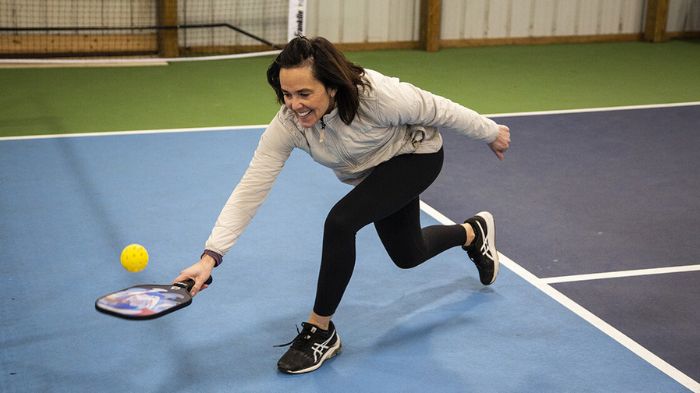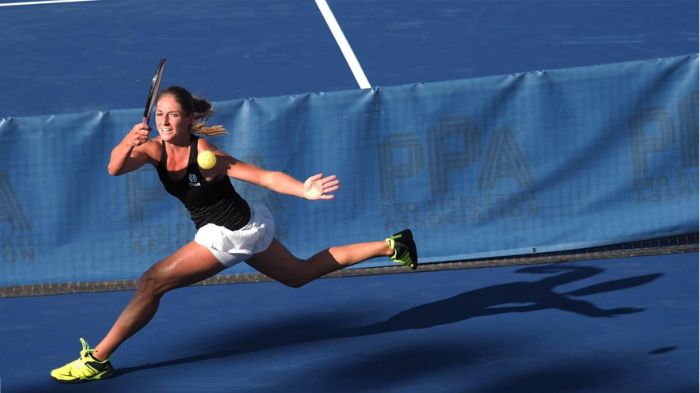Pickleball has gained immense popularity in recent years, attracting players of all ages and skill levels. While many aspects contribute to success in pickleball, one fundamental element that often goes overlooked is footwork.
Efficient footwork plays a crucial role in maintaining balance, positioning, and executing shots effectively. In this blog, we will explore the importance of footwork in pickleball and provide valuable insights, techniques, and drills to help you improve your footwork skills and elevate your game.

Basic Footwork Techniques and Movements
Footwork is a foundational element of any sport, and pickleball is no exception. Efficient footwork in pickleball enables players to move quickly, maintain balance, and position themselves effectively on the court.
Let’s explore the key footwork techniques and movements in pickleball.
Split-Step
The split step is a fundamental footwork technique used to anticipate and react to your opponent’s shots. It involves a small jump, landing with your feet slightly wider than shoulder-width apart. The split step helps you stay light on your feet, maintain balance, and quickly change direction as needed.
Side Shuffle
The side shuffle is a lateral movement technique that can be utilized to shift sideways to reach wide shots or swiftly cover territory along the baseline.
Maintaining a low stance, shuffle your feet laterally while keeping your feet shoulder-width apart. You can keep your balance and position yourself to reach the ball with the help of this action.
Cross-Over Step
You use the cross-over step when you need to quickly change directions. It entails going in the desired direction while crossing one foot over the other.
Cross your left foot over your right foot, for instance, if you need to move to the right. You can transition more easily and cover more ground with this movement.
You can move quickly and fluidly on the court in pickleball by using these fundamental footwork methods. To build muscle memory and enhance your general footwork abilities, practice these motions during drills and game scenarios.
Role of Footwork in Maintaining Balance and Positioning
In pickleball, footwork is essential for maintaining balance and stance. It’s not only about getting to the ball; it’s also about being in the ideal place to make shots and move around the court successfully.
Let’s examine the essential elements of footwork that help pickleball players keep their balance and stance.
Then we go to the ball
You can move fast and effectively toward the ball with good footwork. You can position yourself closer to where the ball will fall by anticipating the direction and trajectory of the ball by performing maneuvers like the split-step and side shuffle.
Keeping a Stable Foundation
In order to hit shots from a stable platform, you need good footwork. Maintaining a stable and balanced stance is crucial for producing power and precision when striking forehands, backhands, or volleys.
You may establish a solid foundation that will enable you to transmit energy efficiently and retain balance throughout your shots by placing your feet shoulder-width apart, distributing your weight evenly, and bending your knees just a little.
Positioning for Shots
Footwork enables you to position yourself optimally for different shots. For example, when approaching the net for volleys, quick and precise footwork helps you move forward efficiently, allowing you to take advantage of shorter volleys and maintain a dominant position.
Similarly, when defending from the baseline or preparing for dinks and third shots, agile footwork enables you to move laterally, adjust your positioning, and be ready to respond to your opponent’s shots effectively.
Key Principles of Efficient Footwork

- Efficiency in pickleball footwork depends on the player’s ability to predict the movement of the ball and act swiftly. You can position yourself beforehand and move quickly to reach the ball by analyzing your opponent’s shots and guessing where the ball will land.
- Maintaining balance and weight transfer correctly is essential for stability and successful shot execution during footwork. You may produce power, regulate your movements, and remain in charge of the game by seamlessly transferring your weight from one foot to the other and keeping your balance in the middle.
- You may travel quickly across the court if you move quickly and with lightness in your steps. You can react quickly to bullets, change directions with ease, and cover more territory by spending as little time as possible on the ground and taking short, nimble strides. This gives you an advantage over your rivals.
Strategies for Different Shots and Situations
- Approaching the net for volleys:
- Take small, quick steps to maintain balance and be ready for fast-paced volleys.
- Keep your weight forward and be prepared to react to shots at the net.
- Use a split step to anticipate the ball and adjust your position accordingly.
- Moving side to side for dinks and third shots:
- Shuffle your feet laterally to quickly move from side to side.
- Maintain a low, athletic stance to improve your agility and reach.
- Focus on keeping your balance and adjusting your positioning based on the shot trajectory.
- Recovering to the baseline for defensive shots:
- Take longer, purposeful strides to quickly move back to the baseline.
- Keep your eye on the ball and anticipate its direction to position yourself effectively.
- Use cross-over steps to cover more ground efficiently and regain a balanced stance.
- Adjusting footwork for lobs:
- Retreat quickly towards the baseline to prepare for a lob shot.
- Take longer, deeper steps to cover the increased distance.
- Use quick, explosive movements to get into position and set up for the shot.
Drills and Exercises to Improve Pickleball Footwork
Shadowing and mimicking footwork patterns of skilled players can train your muscle memory and improve overall movement on the court.
Agility Ladder Drills
To enhance your footwork in pickleball, incorporate agility ladder drills into your training routine. These drills involve navigating through a ladder pattern on the ground, focusing on quick and precise foot movements.
By practicing these drills, you can improve your foot speed, coordination, and overall agility, enabling you to swiftly move around the court and react to shots with ease.
Side-to-Side Movement Drills
Lateral movements play a vital role in pickleball, especially when covering ground during side-to-side shots. Incorporate side-to-side movement drills into your training regimen to develop agility and balance. These drills involve moving laterally across the court while maintaining a stable and balanced stance.
By practicing these drills, you can improve your ability to quickly shift directions, cover more ground efficiently, and maintain stability during dynamic movements.
Shadowing and Mimicking Footwork
One effective way to improve your footwork in pickleball is to shadow and mimic the footwork patterns of skilled players. Watch videos or observe experienced players during matches and practice emulating their footwork techniques.
By mimicking their movements, you can train your muscle memory and develop a better understanding of proper footwork positioning and timing. This exercise will help you refine your own footwork skills and improve your overall movement on the court.
Also Read: pickleball strategy advanced And Can You Toss The Ball Up When Serving In Pickleball?
Common Footwork Mistakes and How to Correct Them
In the game of pickleball, mastering proper footwork is crucial for success on the court. However, players often make certain footwork mistakes that can affect their performance and efficiency.

Understanding these common mistakes and learning how to correct them can greatly improve your pickleball game. Here are some of the most common footwork mistakes and ways to address them:
- Being Flat-Footed or Slow to React: One common mistake is being caught off guard or reacting slowly to the ball. This can result in late or ineffective shots. To correct this, focus on staying on the balls of your feet, ready to move at any moment. Anticipate the shot and be proactive in positioning yourself to quickly respond.
- Crossing Feet or Getting Off Balance: Crossing your feet while moving or hitting the ball can throw off your balance and make it difficult to execute shots accurately. To avoid this, concentrate on taking small, controlled steps and maintaining a wide base. Keep your feet shoulder-width apart to provide a stable foundation.
- Failing to Adjust Footwork for Different Shots: Another mistake is using the same footwork pattern for every shot, regardless of the situation. Different shots require different footwork adjustments. For example, when approaching the net for a volley, take short, quick steps to maintain your balance and be prepared for quick reactions.
Know: What is open play pickleball?
FAQs
Footwork is crucial in pickleball as it allows players to maintain balance, position themselves for shots, and quickly react to the movements of the ball. It helps players reach the ball efficiently and execute shots effectively.
Yes, you can definitely improve your footwork in pickleball. With practice and focus on specific footwork techniques and drills, you can enhance your agility, balance, and overall movement on the court.
Some basic footwork techniques in pickleball include the split step, side shuffle, and cross-over step. The split step involves jumping slightly before the opponent hits the ball to anticipate its direction. The side shuffle helps in lateral movements, while the cross-over step is useful for changing directions quickly.
Common footwork mistakes in pickleball include being flat-footed or slow to react, crossing feet or getting caught off balance, and failing to adjust footwork for different shots. To correct these mistakes, focus on staying light on your feet, maintaining an athletic stance, and practicing specific footwork drills to improve your reaction time and balance.
Yes, there are specific footwork strategies for different shots in pickleball. For example, approaching the net for volleys requires small, quick steps and a forward weight shift. Moving side to side for dinks and third shots involves lateral shuffling and a low, balanced stance. Recovering to the baseline for defensive shots requires longer strides and cross-over steps.
Conclusion
In conclusion, mastering footwork in pickleball is a crucial component for success on the court. By understanding the basic techniques, recognizing the role of footwork in maintaining balance and positioning, and adhering to key principles, you can elevate your game to new heights.
Incorporating strategies for different shots, practicing drills and exercises, and addressing common footwork mistakes will help you develop strong footwork skills. So, lace up your shoes, hit the court, and make footwork your secret weapon in dominating the game of pickleball.



